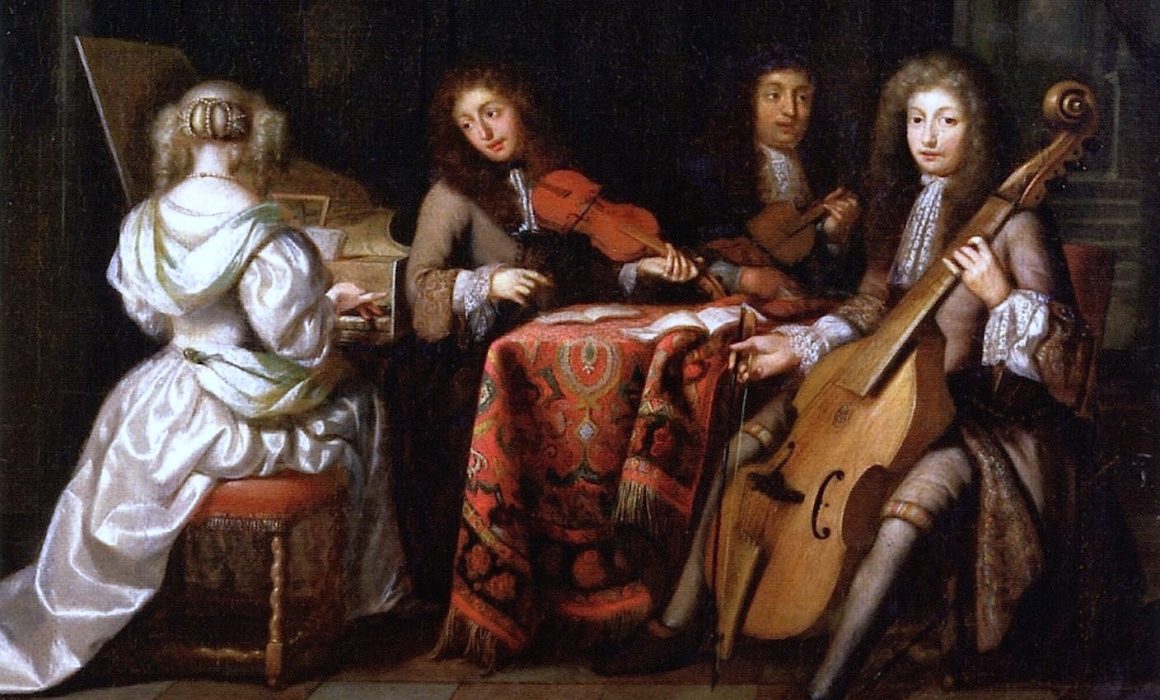The trio sonata, a history
The trio sonata was the perfect meeting ground for the rival claims of the old vocal music and the new instrumental style, and could adapt the old ideas of polyphony to the new concept of accompanied melody.
Christopher Hogwood,
The Trio Sonata, 1979
From the dawn of the period described as the “Baroque,” which spanned 1600 to 1750, the trio sonata brought together all the characteristics that would set it apart as a major genre. The creation in Italy—at the end of the Renaissance—of a form of instrumental music that was not derived from vocal genres, the abandonment of contrapuntal processes as principal methods of composition, the desire to express human passions in the best way possible, and the perfecting of the crafting of violins gave composers a new freedom to experiment with all sorts of sound combinations for ensembles of all sizes, creating what they would call the stile concertato.
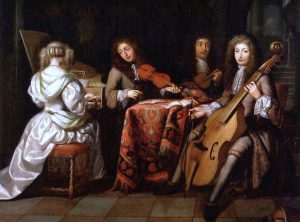
Anonymous painting, circa 1680
They soon began to favour the solo sonata—which, despite the name, includes a basso continuo part—and the trio sonata for two violins and basso continuo. The success of the latter can be explained in that it combined the interesting aspects of polyphonic playing—already tried and tested but with the added flexibility of a new melodic significance—and the emerging principle of accompanied monody, in which the bass line essentially serves to harmonically support the structure. Its success was also, for the most part, due to the fact that it was more accessible to talented amateurs than the solo sonata, which more often calls for greater virtuosity.
This type of sonata is called a “trio” because it involves three melodic lines, two toplines and one bass, not necessarily three performers (the terms “trio” or “quartet” only came to designate the number of players beginning in the second half of the 18th century). Therefore, four musicians are often required to play a trio sonata: two to deal with the melody voices, and two for the bass. This lower line is handled by a bowed bass (a viola da gamba, a cello), or even a bassoon, with a harmonic instrument (harpsichord, organ, or archlute) doubling it, while “producing” the required harmonies—indicated with a coding system—at the player’s discretion, often in an improvised way depending on the venue or the circumstances, but always in good taste. (Certain period drawings show the cellist craning his neck to follow his line on the harpsichordist’s score, as publishers did not print two copies… and photocopiers had not yet been invented…) However, on a structural level, the bowed bass on its own or a sole harmonic instrument would suffice, as indicated on several title pages in print collections.
Different types of collaboration govern the ways in which the two instruments playing the bass line work with each other. We can hear polyphony with rather strict imitative playing; the principal melody played by one and a sort of accompanying countermelody by the other; different melodic patterns for each voice (creating a sort of dialogue with questions and responses); or a simple parallel arrangement of the two, in thirds or sixths. A skillful blend of these diverse conversations could even take place within the same work.
Early on, in a spirit of contrast typical of the Baroque, sonatas linked together various tempos and rhythms without any real interruption, but starting in the 1680s, influenced by the dance suite, the movements were separated according to a general slow-fast-slow-fast pattern. This led to a differentiation between the sonata da camera (chamber sonata), whose sections are dances—often those of the dance suite: Allemande, Courante, Sarabande, and Gigue—and the sonata da chiesa (church sonata)—which designates its movements with indications of tempo or character, as dance was forbidden in church. But this distinction was often only superficial, with a Sarabande simply marked Adagio, or a Presto hiding a lively gigue…
Among the earliest examples of the trio sonata were those of Salomone Rossi (1570-1630), a Jewish violinist who was a colleague of Claudio Monteverdi in Mantua. In 1607, he published a book of twenty-seven short pieces, among which fifteen were sinfonias for two violins and basso continuo—the 11th exhibiting a (too) brief echoing dialogue. The title page of Rossi’s collection states that the violins can be replaced by cornetts, a very popular instrument at the time, much like the recorder—a practice no doubt in part intended to increase sales… A few years later, in 1621 and 1629, in Venice, Dario Castello (1602-1631), head instrumentalist at St. Mark’s Basilica under the direction of Monteverdi, published two collections of Sonate concertate in stil moderno for two to four voices. Sonata No. 11 from the second book is a trio: in a succession of highly contrasting sections, the two melodic instruments, left to the choice of the performers, freely dialogue and compete in what seems like an improvised manner, a style of composition that the Germans would later call phantasticus.
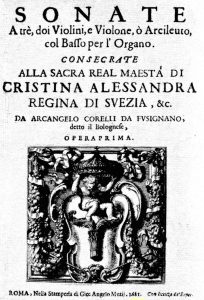
Title page of Arcangelo Corelli’s Opus I, 1681
At the end of the 17th century, in a sort of process of formalization, the sonata was given a makeover, as its movements—most often in binary form—became clearly separated, with rhythmic stability and steady tempos in each, and an affirmation of tonality. Accomplished violinist Arcangelo Corelli (1653-1713), the protégé in Rome of Queen Christina of Sweden and then of Cardinal Ottoboni, was the great artisan of this “classical” form. The perfection, moderation, and balance of his body of work set a standard that spread throughout Europe in the following decades. Published from 1681 to 1694, the first four of his six collections of instrumental music each feature twelve trio sonatas, da camera and da chiesa, which alternate between essentially harmonic movements, dances, and fugal movements—the only complaint that could be made of them today would be with respect to their brevity… Thanks to Corelli, the trio sonata, as of 1700, became the genre par excellence in which all young composers had to prove themselves, demonstrating both their melodic talents and their contrapuntal skills.
Throughout the 17th century, each country adapted the genre to its own spirit. The German masters
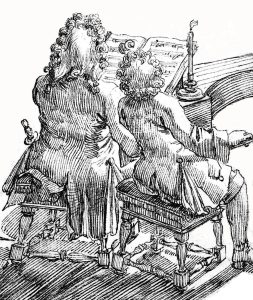
A basso continuo, drawing by Pier Leone Ghezzi, circa 1720
had formidable violin virtuosos in their ranks, just as worthy as their colleagues on the Peninsula, and they did their best to combine the French and Italian styles in an altogether personal way, often with a unique depth of expression. Sometimes, creating a darker character to the sound, they replaced the second violin with a viola da gamba, an instrument that was quite popular north of the Alps. This was the allotment—one melody voice and two basses—that Dietrich Buxtehude (1637-1707) adopted in his two collections, published in 1694 and 1696, with seven trio sonatas in each—they are called “for two” on their title pages as it was sometimes thought that the bass would not take part in the counterpoint. The composer did not stick to a fixed sequence of movements, alternating the “fantasque” style, fugal writing, and the formal structure of various dances, sometimes on a chaconne bass, as in Sonata Op. 2 No. 3.
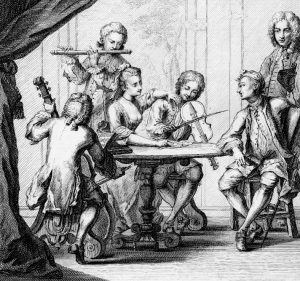
Drawing by Marcellus Laroon, circa 1720
A few years later, the newly perfected Corellian model, amplified and often adapted to the flute, spread throughout Germany. Though his father did not practice it very much in its “classic” form, it was with the trio sonata that Carl Philipp Emanuel Bach (1714-1788) cut his teeth. Following the example of his godfather, Georg Philipp Telemann, he wrote a few of them in his early twenties, while studying law in Frankfurt between 1734 and 1738. He returned to these sonatas—which adopt the tripartite structure of the Vivaldian concerto—after settling in Berlin, where the flute was in the spotlight, given Frederick II’s passion for the instrument. With his very personal approach, Bach fils showed that the new gallant and sensitive style still had a place for itself in the genre, even though it was already beginning to make way for other, more modern practices.
In France, where a very distinctive musical style reigned, Italian music was long kept at bay and the violin as a solo instrument was considered too strident and only suited for dance music—the delicate sounds of the viol were preferred for chamber music. It was in Parisian salons—rather than at Versailles, where the court huddled around a pious and aging Louis XIV—that Italian sonatas were first heard beginning in the 1690s. These included Corelli’s, of course, which generated immediate enthusiasm among both music lovers and composers. Alongside François Couperin, totally won over but seeking to achieve a union of French and Italian ways, there was Jean-Féry Rebel (1666-1747), an exceptional violinist who studied composition with Jean-Baptiste
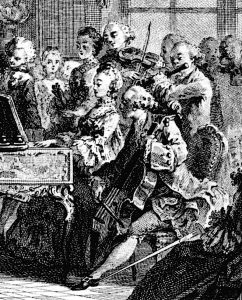
Engraving after Augustin de Saint-Aubin, 1774
Lully. In 1712, he published twelve Sonates à 2 ou 3 parties (which, however, dated to 1695). “Rebel truly infused them with Italian genius and fire, but he also had the good taste and sense to temper them with French wisdom and gentleness,” as noted by Le Cerf de la Viéville, and as evidenced by the lovely tribute he paid to his teacher in the seventh of his sonatas, Le tombeau de Monsieur de Lully.
In certain passages of their sonatas, French composers, like Couperin and Rebel, wrote a different line than that of the basso continuo for the bowed bass: the gamba or cello could simply add figures linking the long notes of the bass or could be entrusted with an independent part, thereby creating a four-voice texture for their trio sonatas. This formation would pave the way for the four-voice sonata genre—two melody lines and two bass lines—some of the finest examples of which can be heard in Telemann’s Paris Quartets.
But this concert concludes with a quartet for three melody voices and bass. Early in his
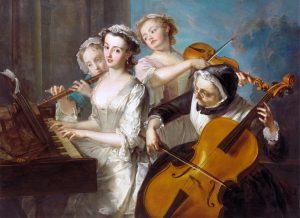
Painting by Philippe Mercier, circa 1745
career, in 1755, a member of an important musical dynasty, François André Danican Philidor (1726-1795)—who went on to become one of the most famous chess players of all time—published L’Art de la modulation, a collection of six quartets for oboe or flute, two violins, and basso continuo. Quartet No. 3 presents a gallant discourse that is already almost classical: following an elegant Moderato are two Arias (the first labelled Gratioso and the second in a minor key) and a gigue that is constructed like a biting dialogue between the flute and the violins.
© François Filiatrault, 2023
Translated by John Trivisonno
The Trio sonata, a history concert will be presented on November 24, 2023 at 7:30pm at Salle multimédia – Conservatoire de Montréal


